1988 PONTIAC FIERO transmission oil
[x] Cancel search: transmission oilPage 1022 of 1825
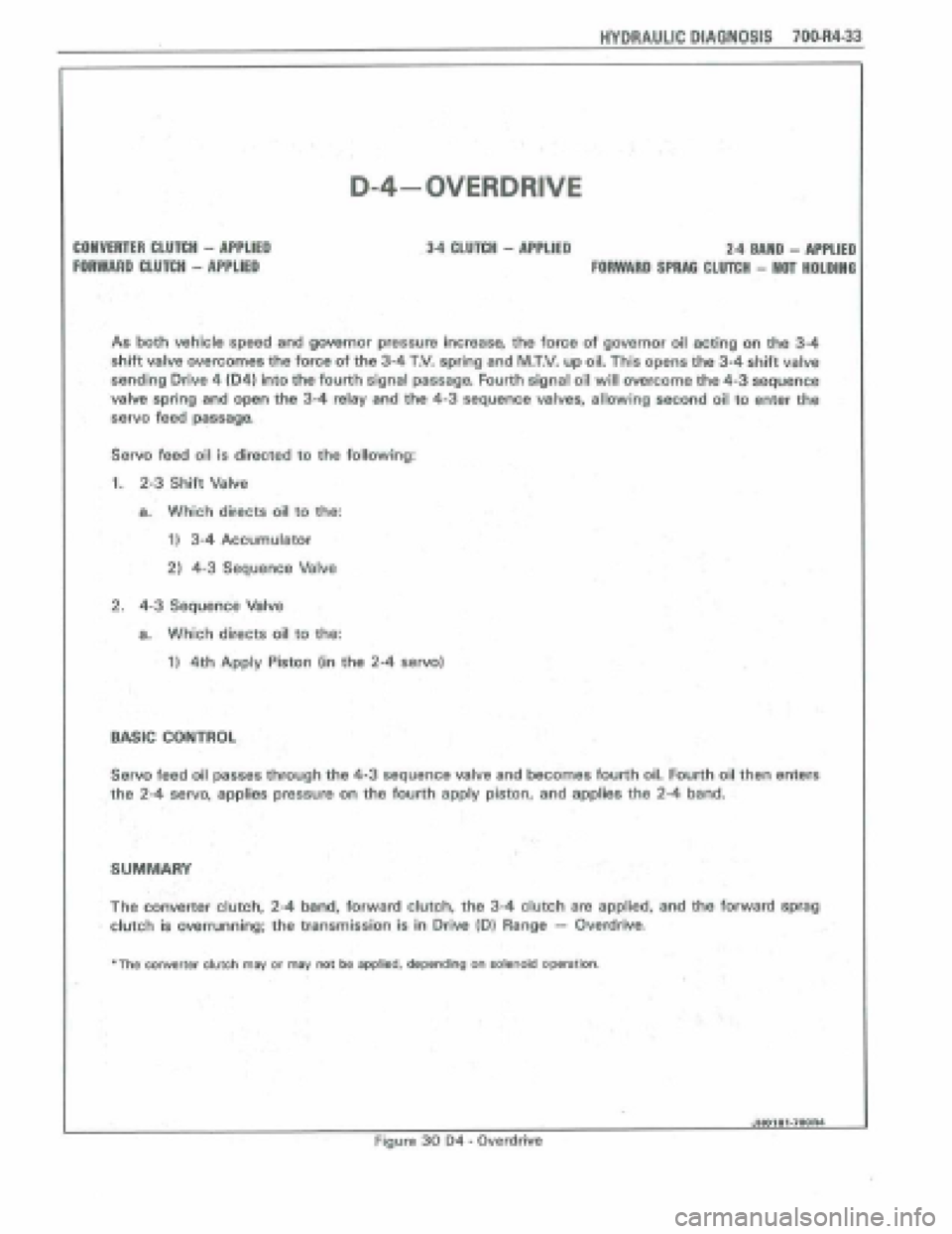
D-4- OVERDRIVE
HYDRAUUC DIAGNOSIS 70044-33
CONVERTER CLUTCH - APPLIED 9-4 CLUKH - APPLIED 24 3AlD - APPLIED
FORWARO CLUTCH - APPLIED FORWARD SPRM CLUTCH - HOT HOLDlNO
As both vehlcle speed and governor pressure incwaae, the force of governor oil acting on the 3-4
shift valve overcomes the force of the 3-4 T.V, spring and M.T.V. up oil. This opens the 3-4 shift valve
sending Drive 4 lD41 into the fourth signal passage. Fourth signal oil will overcome the 4-3 sequence
valve spring and open the 3-4 relay and the 4-3 sequence valves, allowing second oil to enter the
servo feed passage.
Servo feed oil is directed to the following:
1. 2-3 Shift Valve
a. Which directs oil to the:
1) 3-4 Accurnuiator
2) 4-3 Sequence Valve
2. 4-3 Sequence hive
a. Which directs oil to the:
1) 4th Apply Piston (in the 2-4 servo)
SUMMARY
The converter clutch, 24 band, forward clutch, the 3-4 clutch an applied, and the forward sprag
clutch is werrunning; the transmission is in Drive (D) Range - Overdrive,
*Tha converter clutch may or may not ba applied, depending on denoid operation.
JHOI er.?ow
Figure 30 b4 - Overdrive
BASIC CONTROL
Servo feed oil passes through the 4-3 sequence valve and becomes fourth oil. Fourth oil then enters
the
2-4 servo, applies pressure on the fourth apply piston, and applles the 2-4 band.
Page 1026 of 1825
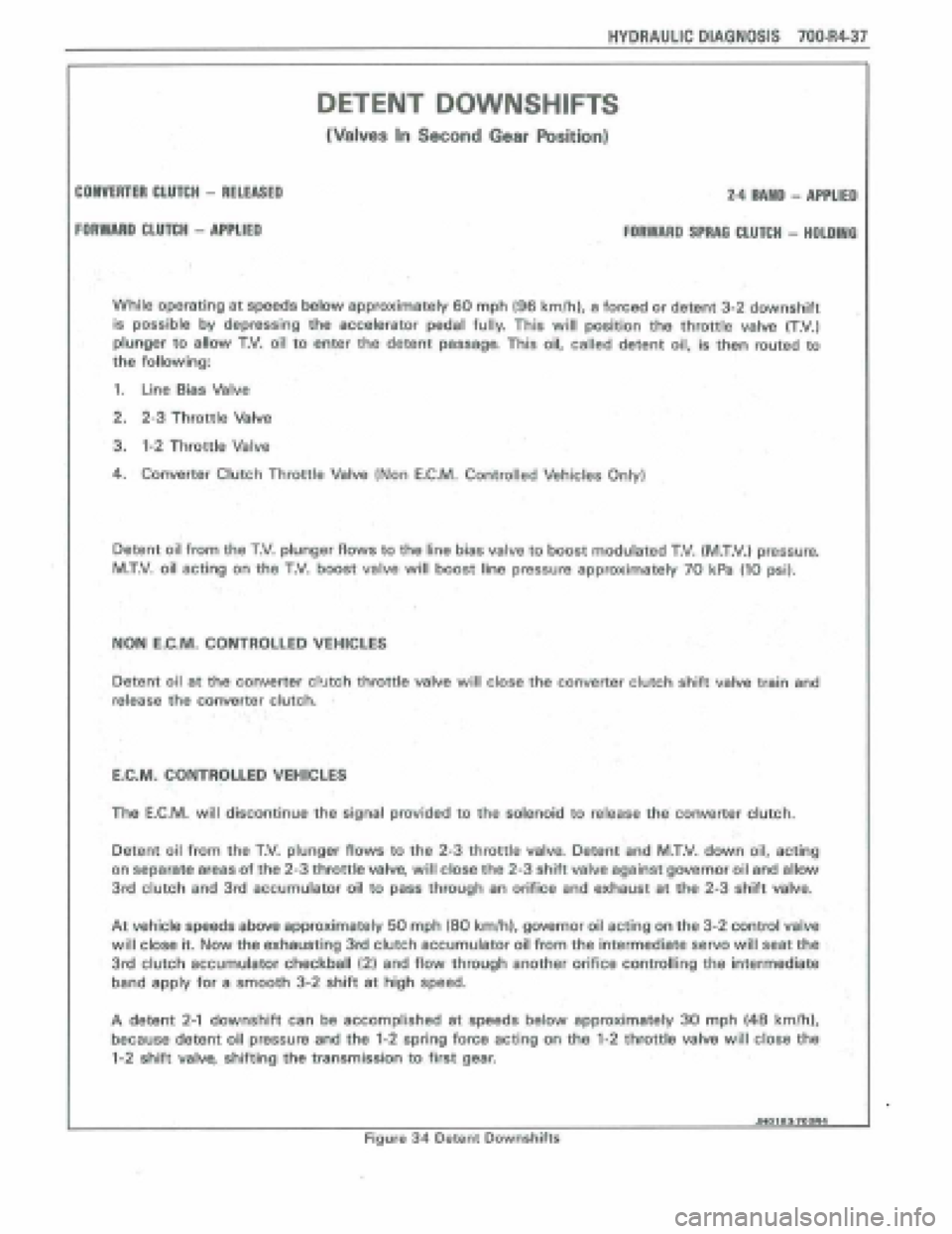
HYDRAULIC DIAGNOSIS 7004437
COIYVEIWER CLUTCH - RELEASED
FORWARD CLUltH - APPUEO
DETENT DOWNSHIFTS
1Valves In Second Gear Position)
2.4 BAND - APPLIED
FORWARD
SPRAQ CLUTCH - HOLDING
While operating at speeds below approximately 60 mph (96 kmth), a forced or detent 3-2 downshift
is possible by dapressing the accelerator pedal fully. This will position the throttle valve {T.V.}
plunger to allow T.V. oil to enter the detent passage. This oil, called detent oil, is then routed to
the following:
I. Line Bias Valve
2. 2-3 Throttle Valve
3. 1-2 Throttle Valve
4. Converter Clutch Throttle Valve (Non EC.M. Controlled Vehicles Only}
Detent ail from the T.V. plunger flows to the line bias valve to boost modulated T.V. (M.T.V.1 pressure.
M.T.V. oil acting on the T.V. boost valve will boost line pressure approximately 70 kPa (10 psi).
NON E.C.M. CONTROLLED VEHICLES
Detent oil at the cmverter clutch throttle valve will close the converter clutch shift valve train and
release the converter clutch.
E.C.M. CONTROLLED VEHCLES
The E.C.M. wll discontinue the signal provided to the solenoid to release the converter ctutch.
Dstent oil from the 7.V. plunger flows to the 2-3 throttle valve. Detent and M.T.V. down ol, acting
on separate
areas of the 2-3 throttle valve, will close the 2-3 shift valve against governor oil and allow
3rd clutch and 3rd accumulator oil to pass through an orifice and exhaust at the 2-3 shift valve.
At vehicle speeds above approximately 50 rnph (80 km/h), governor oil acting on the 3-2 control valve
will close it. Now the exhausting 3rd clutch accumulator oil from the inxemediate servo will seat the
3rd clutch accumulator checkball
(21 and low through another orifi~e controlling the intermediate
band apply for
a smooth 3-2 shift at high speed.
A detsnt 2-1 downshift can be accomplished at speeds below approximately 30 mph 148 krnlh),
because detent oil pressure and the 1-2 spring force acting on the 1-2 throttle valve will close the
1-2 shift valve, shifting the transmission to first gear.
JH018S-700A4
Figure 34 Deterit Downshifts
Page 1028 of 1825
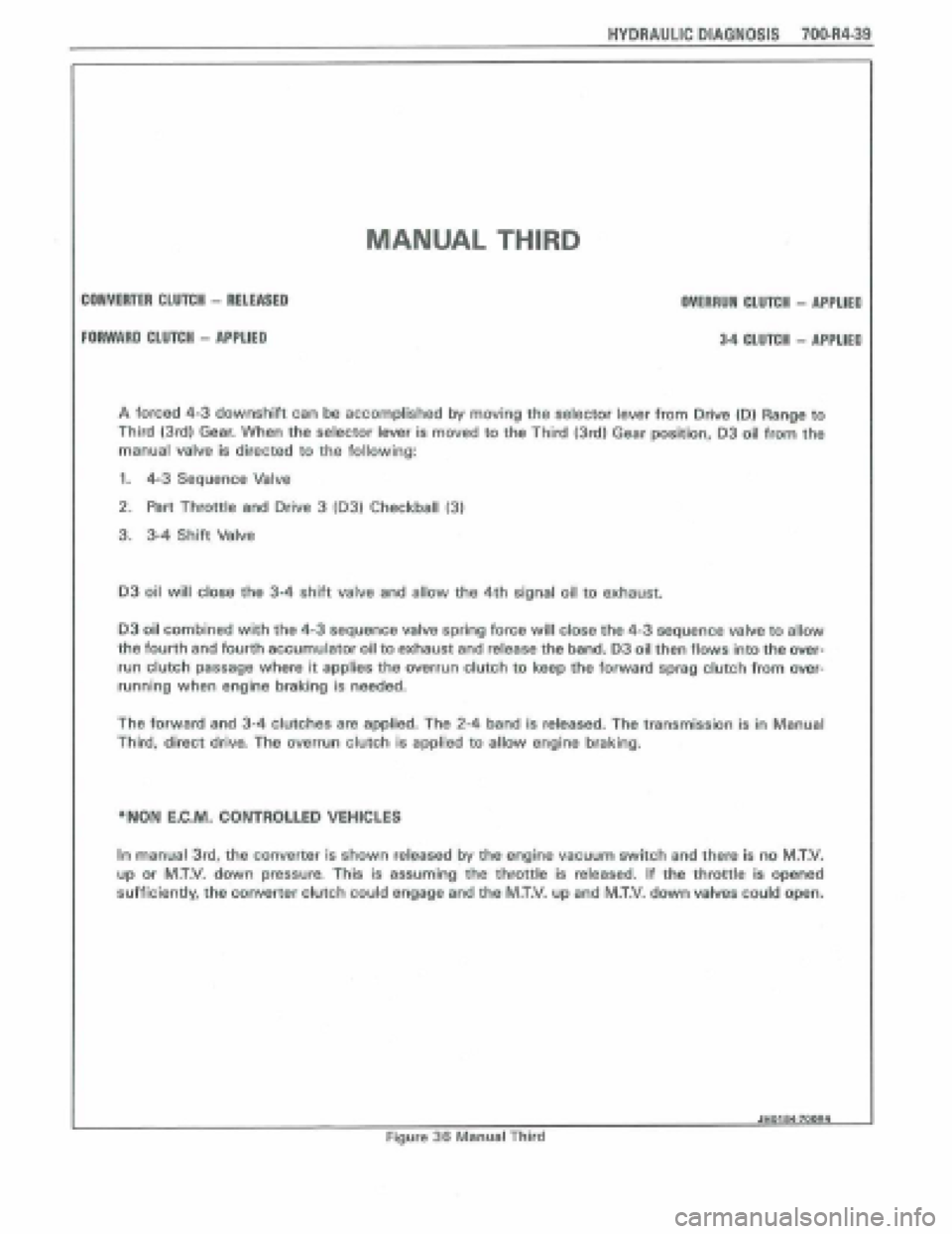
HYDRAULIC DIAGNOSIS 70044-39
MANUAL THIRD
CONVERTER CLUTCH - RELEASED
FORWARD CLUTCH - APPLIED
OVERRUN CLUTCH - APPUED
3.4 CLUfeH - APPLIEP
A forced 4-3 downshift can be accomplished by moving the selector lever from Drive 10) Range to
Third {3rd) Gear. When the selector lever is moved to the Third (3rd) Gear position, 03 oil from the
manual
valve is directed to the following:
1. 4-3 Sequence Valve
2. Part Throttle and Drive 3 103) Checkball 131
3. 3-4 Shift Valve
03 oil will close the 34 shift valve and allow the 4th signal oil to exhaust.
D3 oil combined with the 4-3 sequence valve spring force will close the 4-3 sequence valve to allow
the fourth and fourth accumulator oil to exhaust and release the band. 03 oil then flows into the over-
run clutch passage where it applies the overrun clutch to keep the forward sprag clutch from over-
running when engine braking is n~eded.
The forward and 3-4 CIU~C~~S are applied. The 2-4 band is released. The transmission is in Manual
Third,
direct driva The overrun clutch is appRad to allow engine braking.
*NON E,C.M, CONTROLLED VEHICLES
In manual 3td, the converter is shown released by the engine vacuum switch and there is no M.T.V.
up or M.T.V. down pressure, This is assuming the throttle is released. If the throttle is opened
sufficiently, the converter clutch could engage and the M.T.V. up and MXV. down valves coJd open.
JHOtOQ7WRI I
Figure 36 Manual Third
Page 1030 of 1825

, HYDRAULIC PlAGNQSlS 7004441
MANUAL SECOND
COWERTER CLUTCH - RELEASED
OVEARUN CLUTCH - APPLIED
2.4 MUD - APPLIED
I
FORWARD CLUTCH - APPLIED
I
A forced 3-2 downshift cen be a~cornplished by moving the selector lever from Third (3rd) Gear to
Second (2nd) Gear position.
When
the selector lever is moved to the Second (2nd) Gear position, RND4D3, 3rd clutch, and 3rd
accumulator oil
will exhaust at the manual valve, With no pressure to apply the 34 clutch, or release
the 2-4 band, the transmission will shift to second gear.
The manual valve will also direct line pressure into the D2 passage, Drive 2 (D2) oil will act on the
reverse boost valve to boost line pressure to 1206 kPa (I75 psi) which is required to prevent the 2-4
band and forward clutch from slipping.
SUMMARY
The forward clutch and 2-4 band are applied. The transmission is in second gear. Also, the werrun
clutch is still applied to allow engine braking when needed.
JHOlUWOOR4 1
Figure 38 Manual Se~ond
Page 1032 of 1825

MANUAL LO
CONVERTEM CLUTCH - RELEASED
FORWARD CLUTCH - APPLIED
Maximum downhill braking can be obtained at speeds below 30 mph (48 kmlh) with the selector
in Lo (tat) range. Lollst oil pressure, which is 1206 kR I175 psi), is the same as second (2nd) oil pressure
because second (02) oil is still present.
Lo oil from the manual valve is directed to the following:
1* 1-2 Shift Valvelain
2. to and Reverse Clutch
3. Lo Overrun Valve
Lo oil at the 1-2 T.V. valve combined with the 1-2 throttle valve spring force will close the 1-2 shift
valve at speeds approximately 36 mph 156 km/h) or below. This allows 2nd oil to exhaust, releasing
the 2-4 band, and lo oil to apply the lo and reverse clutch.
Loflst oil coming off the 1-2 T.V* valve is directed toward the lo overrun valve that regulates lolreverse
oil. This smoothes the 2-1 manual downshift for maximum engine braking.
The forward clutch is applied. The lo and reverse, and the overrun clutch are applied to allow engine
braking.
The 2-4 band is released, the transmission is in Lo Range - First Gear.
HYDRAULIC DIAGNOSIS 700-RU3
OVEARUM CLUTCH - APPLIED
LO ROLLER CLUTCH - APPLIED
JH018&7WR4
Figure 40 Manual Lo
Page 1034 of 1825

HYDRAULIC DIAGNOSIS 700-84-45
REVERSE
REVERSE INPUT CLUTCH - APPLIED
LO AND REVERSE CLUTCH - APPLIED
When the selector lever is moved to the Reverse (R) position, the manual valve is repositioned to allow
line pressure to enter the reverse passage which directs oil to the following:
1. Lo and Reverse Clutch
2. Reverse Input Clutch
3. Reverse Boost Valve
4. Lo Overrun Valve
Reverse oil is
orificed at the retainer and ball assembly, and regulated at the lo overrun valve to apply
the lo and reverse clutch.
Reverse oil is
orificed into the reverse input clutch and orificed out of the reverse input piston for a
smooth apply of the reverse input clutch during the shift.
Reverse oil acting on the reverse boost valve in the pressure regulator will boost line pressure to
approximately 670
kPa (100 psi). M.T.V. oil from the line bias valve acting on the T.V. boost valve,
in the pressure regulator, will further boost line pressure from 670
kPa (100 psi) at idle to 1690 kPa
(245 psi) at full throttle.
The reverse input clutch is applied. The lo and reverse clutch is applied. The transmission is in
Figure 42 Reverse
Page 1050 of 1825
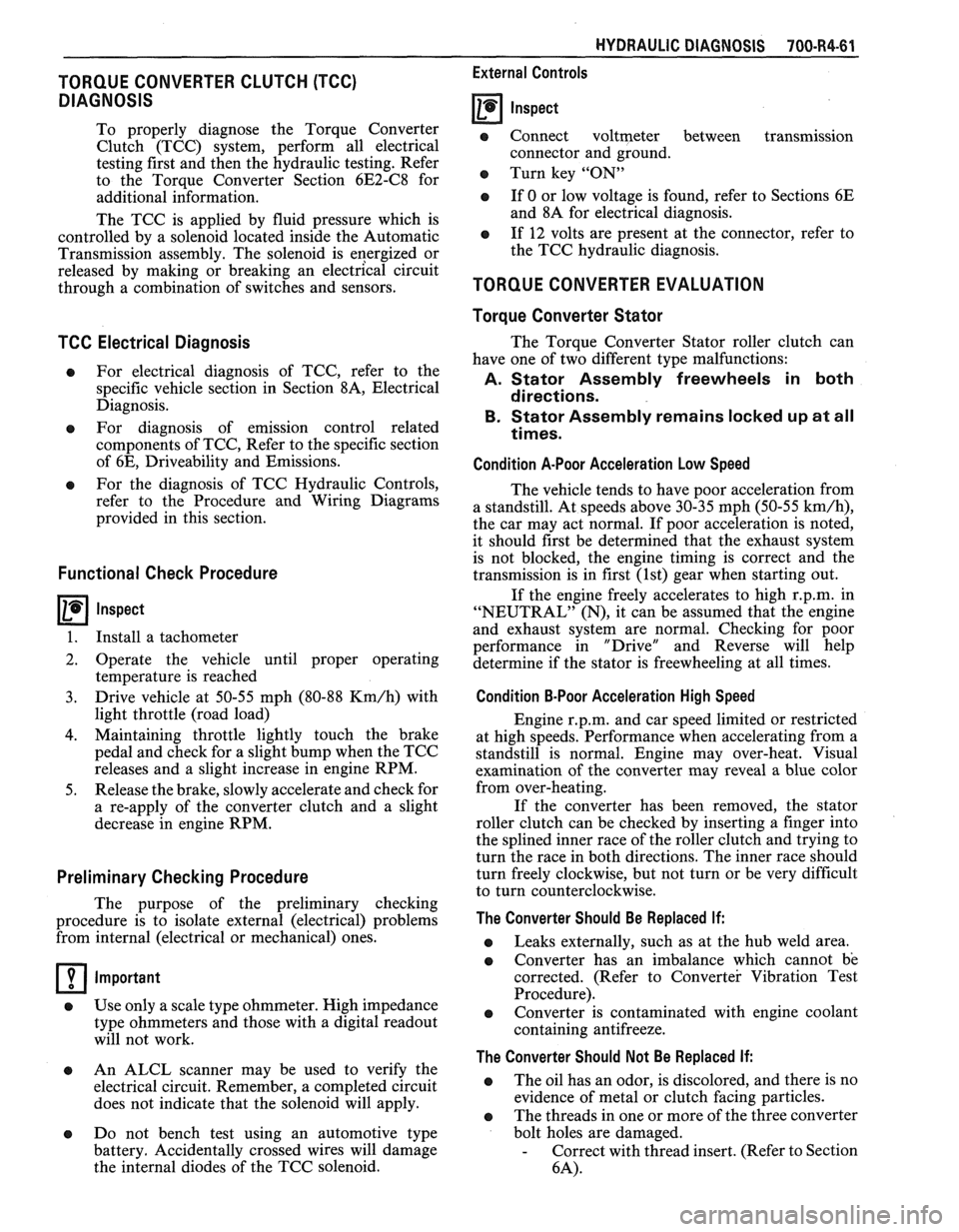
TORQUE CONVERTER CLUTCH (TCC)
DIAGNOSIS
To properly diagnose the Torque Converter
Clutch (TCC) system, perform all electrical
testing first and then the hydraulic testing. Refer
to the Torque Converter Section
6E2-C8 for
additional information.
The TCC is applied by fluid pressure which is
controlled by a solenoid located inside the Automatic
Transmission assembly. The solenoid is energized or
released by making or breaking an electrical circuit
through a combination of switches and sensors.
TCC Electrical Diagnosis
e For electrical diagnosis of TCC, refer to the
specific vehicle section in Section
8A, Electrical
Diagnosis.
e For diagnosis of emission control related
components of TCC, Refer to the specific section
of
6E, Driveability and Emissions.
e For the diagnosis of TCC Hydraulic Controls,
refer to the Procedure and Wiring Diagrams
provided in this section.
Functional Check Procedure
rn Inspect
1. Install a tachometer
2. Operate the vehicle until proper operating
temperature is reached
3. Drive vehicle at 50-55 mph (80-88 Km/h) with
light throttle (road load)
4. Maintaining throttle lightly touch the brake
pedal and check for a slight bump when the TCC
releases and a slight increase in engine RPM.
5. Release the brake, slowly accelerate and check for
a re-apply of the converter clutch and a slight
decrease in engine RPM.
Preliminary Checking Procedure
The purpose of the preliminary checking
procedure is to isolate external (electrical) problems
from internal (electrical or mechanical) ones.
Important
e Use only a scale type ohmmeter. High impedance
type ohmmeters and those with a digital readout
will not work.
e An ALCL scanner may be used to verify the
electrical circuit. Remember, a completed circuit
does not indicate that the solenoid will apply.
e Do not bench test using an automotive type
battery. Accidentally crossed wires will damage
the internal diodes of the TCC solenoid.
HYDRAULIC DIAGNOSIS 700-R4-61
External Controls
rn Inspect
e Connect voltmeter between transmission
connector and ground.
e Turn key "ON"
e If 0 or low voltage is found, refer to Sections 6E
and 8A for electrical diagnosis.
e If 12 volts are present at the connector, refer to
the TCC hydraulic diagnosis.
TORQUE CONVERTER EVALUATION
Torque Converter Stator
The Torque Converter Stator roller clutch can
have one of two different type malfunctions:
A. Stator Assembly freewheels in both
directions.
B. Stator Assembly remains locked up at all
times.
Condition A-Poor Acceleration Low Speed
The vehicle tends to have poor acceleration from
a standstill. At speeds above 30-35 mph (50-55
km/h),
the car may act normal. If poor acceleration is noted,
it should first be determined that the exhaust system
is not blocked, the engine timing is correct and the
transmission is in first
(1st) gear when starting out.
If the engine freely accelerates to high
r.p.m. in
"NEUTRAL" (N), it can be assumed that the engine
and exhaust system are normal. Checking for poor
performance in "Drive" and Reverse will help
determine if the stator is freewheeling at all times.
Condition B-Poor Acceleration High Speed
Engine r.p.m. and car speed limited or restricted
at high speeds. Performance when accelerating from a
standstill is normal. Engine may over-heat. Visual
examination of the converter may reveal a blue color
from over-heating.
If the converter has been removed, the stator
roller clutch can be checked by inserting a finger into
the splined inner race of the roller clutch and trying to
turn the race in both directions. The inner race should
turn freely clockwise, but not turn or be very difficult
to turn counterclockwise.
The Converter Should Be Replaced If:
e Leaks externally, such as at the hub weld area.
e Converter has an imbalance which cannot be
corrected. (Refer to Converter Vibration Test
Procedure).
e Converter is contaminated with engine coolant
containing antifreeze.
The Converter Should Not Be Replaced If:
e The oil has an odor, is discolored, and there is no
evidence of metal or clutch facing particles.
e The threads in one or more of the three converter
bolt holes are damaged.
- Correct with thread insert. (Refer to Section
6A).
Page 1052 of 1825
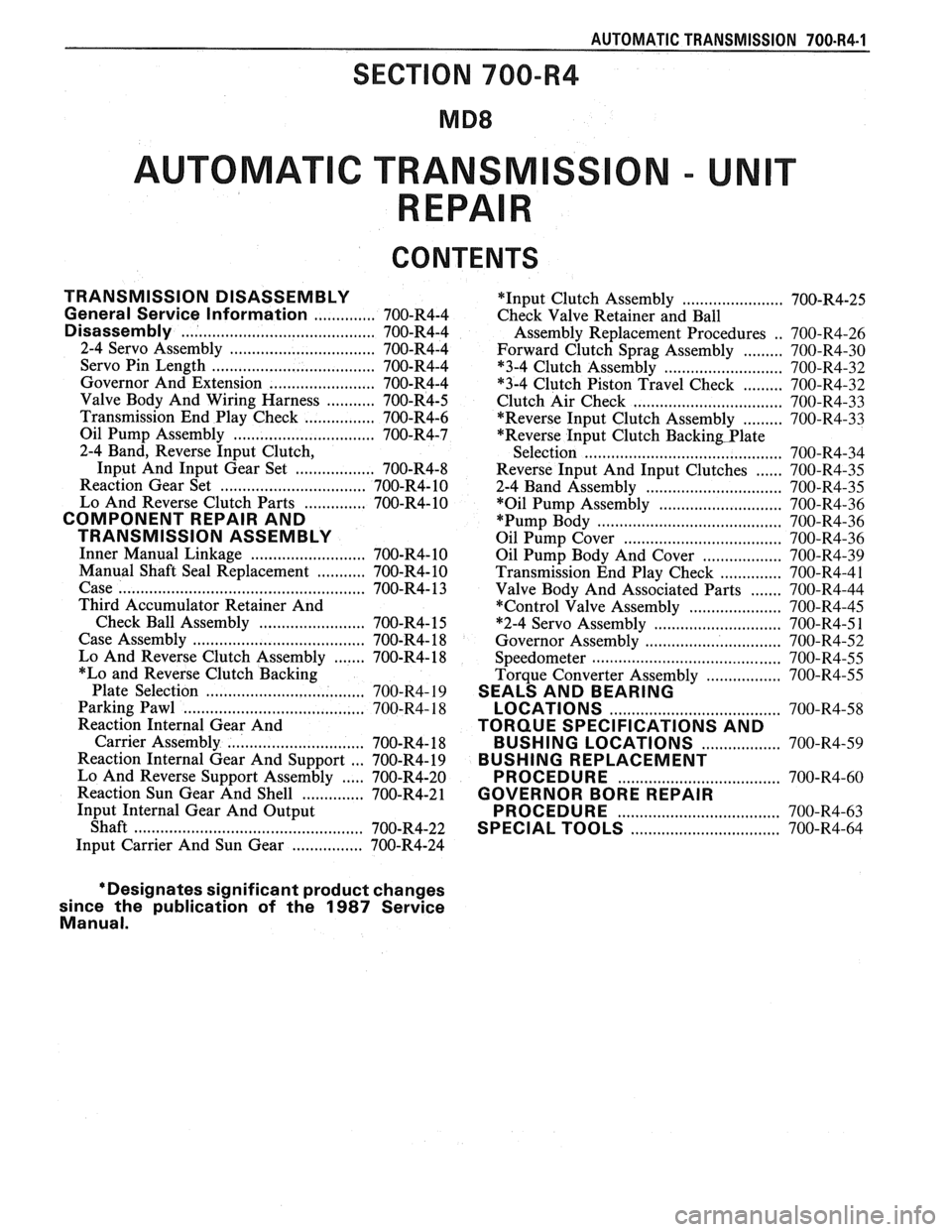
AUTOMATIC TRANSMISSION 700-R4-1
AUTOMAT C TRANSM
CONTENTS
TRANSMISSION DISASSEMBLY
.............. General Service Information 700-R4-4
........................................... Disassembly 700-R4-4
2-4 Servo Assembly
................................. 700-R4-4
.................................. Servo Pin Length 700-R4-4
........................ Governor And Extension 700-R4-4
Valve Body And Wiring Harness
........... 700-R4-5
................ Transmission End Play Check 700-R4-6
Oil Pump Assembly
................................ 700-R4-7
2-4 Band. Reverse Input Clutch.
.................. Input And Input Gear Set 700-R4-8
Reaction Gear Set
................................. 700-R4- 10
.............. Lo And Reverse Clutch Parts 700-R4-10
COMPONENT REPAIR AND
TRANSMISSION ASSEMBLY
Inner Manual Linkage .......................... 700-R4- 10
........... Manual Shaft Seal Replacement 700-R4-10
Case
...................................................... 700-R4- 13
Third Accumulator Retainer And
Check Ball Assembly
........................ 700-R4- 15
Case Assembly
............................. ., ...... 700-R4- 18
Lo And Reverse Clutch Assembly
....... 700-R4- 18
*Lo and Reverse Clutch Backing
Plate Selection
.................................. 700-R4- 19
..................................... Parking Pawl 700-R4- 18
Reaction Internal Gear And
Carrier Assembly
.............................. 700-R4- 18
Reaction Internal Gear And Support
... 700-R4- 19
Lo And Reverse Support Assembly
..... 700-R4-20
Reaction Sun Gear And Shell
.............. 700-R4-21
Input Internal Gear And Output
.................. Shaft .......................... ... 700-R4-22
................ Input Carrier And Sun Gear 700-R4-24 *Input
Clutch Assembly
....................... 700-R4-25
Check Valve Retainer and Ball
Assembly Replacement Procedures
. . 700-R4-26
Forward Clutch Sprag Assembly
......... 700-R4-30
*3-4 Clutch Assembly
.......................... 700-R4-32
......... "3-4 Clutch Piston Travel Check 700-R4-32
Clutch Air Check
................................. 700-R4-33
......... *Reverse Input Clutch Assembly 700-R4-33
"Reverse Input Clutch
Backin~Plate
Selection ...................................... 700-R4-34
Reverse Input And Input Clutches
...... 700-R4-35
2-4 Band Assembly
.............................. 700-R4-35
*Oil Pump Assembly
............................ 700-R4-36
"Pump Body .......................................... 700-R4-36
Oil Pump Cover
.................................... 700-R4-36
Oil Pump Body And Cover
.................. 700-R4-39
Transmission End Play Check
.............. 700-R4-4 1
....... Valve Body And Associated Parts 700-R4-44
*Control Valve Assembly
..................... 700-R4-45
*2-4 Servo Assembly
............................. 700-R4-5 1
Governor Assembly ............................... 700-R4-52
........................................... Speedometer 700-R4-55
Torque Converter Assembly
................. 700-R4-55
SEALS AND BEARING
....................................... LOCATIONS 700-R4-58
TORQUE SPECIFICATIONS AND
.................. BUSH l NG LOCATIONS 700-R4-59
BUSHING REPLACEMENT
..................................... PROCEDURE 700-R4-60
GOVERNOR BORE REPAIR
PROCEDURE
......................... ............ 700-R4-63
...... ...................... SPECIAL TOOLS .. 700-R4-64
*Designates significant product changes
since the publication of the
1987 Service
Manual .